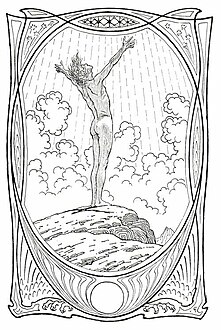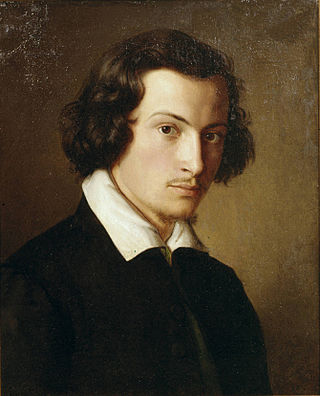
Philipp Veit was a German Romantic painter and one of the main exponents of the Nazarene movement. It is to Veit that the credit of having been the first to revive the nearly forgotten technique of fresco painting is due.

The Völkisch movement was a German ethnic nationalist movement active from the late 19th century through to the dissolution of the German Reich in 1945, with remnants in the Federal Republic of Germany afterwards. Erected on the idea of "blood and soil", inspired by the one-body-metaphor, and by the idea of naturally grown communities in unity, it was characterized by organicism, racialism, populism, agrarianism, romantic nationalism and – as a consequence of a growing exclusive and ethnic connotation – by antisemitism from the 1900s onward. Völkisch nationalists generally considered the Jews to be an "alien people" who belonged to a different Volk from the Germans.
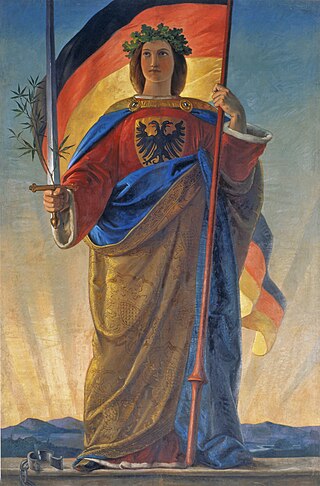
Germania is the name of a painting that was probably created in March 1848. It hung in the St. Paul's Church (Paulskirche) in Frankfurt, Germany. At that time, first the so-called Pre-Parliament and then the Frankfurt National Assembly, the first all-German parliament, met there. The National Assembly was a popular motif of the time, so the Germania painting also became very well-known. After the National Assembly was violently terminated in May 1849, the painting was taken down. In 1867 it was moved to the German National Museum in Nuremberg.
Árpád von Nahodyl is a German writer, neopagan activist and politician. His books on pagan subjects as well as esoteic, devination and mythology are published under the pseudonym Géza von Neményi. Active in Germany's neopagan scene since the early 1980s, he founded the Heidnische Gemeinschaft which attracted media attention and controversy in that decade. After leaving the organization, he founded the Germanische Glaubens-Gemeinschaft in 1991. He is the groups spirituel leader and calls him self Allsherjagode.
The Alcis or Alci were a pair of divine young brothers worshipped by the Naharvali, an ancient Germanic tribe from Central Europe. The Alcis are solely attested by Roman historian and senator Tacitus in his ethnography Germania, written around 98 AD.
Ludwig Fahrenkrog was a German painter, illustrator, sculptor and writer. He was born in Rendsburg, Prussia, in 1867. He started his career as an artist in his youth, and attended the Berlin Royal Art Academy before being appointed a professor in 1913. He taught at the School of Arts and Crafts in Bremen from 1898 to 1931. He was also involved in the founding of a series of modern Pagan religious groups in the early 20th century, as part of a movement to create what its adherents referred to as a "Germanic religious community".

Walter Gramatté was a German expressionist painter who specialized in magic realism. He worked in Berlin, Hamburg, Hiddensee and Barcelona. He often painted with a mystical view of nature. Many of his works were inspired by his experiences in the First World War and his illness.
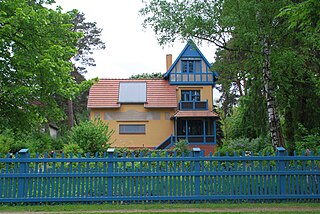
Fidus was the pseudonym used by German illustrator, painter and publisher Hugo Reinhold Karl Johann Höppener. He was a symbolist artist, whose work directly influenced the psychedelic style of graphic design of the late 1960s.
Germany and Austria have spawned many movements and practices in Western esotericism, including Rosicrucianism, Theosophy, Anthroposophy and Ariosophy, among others.

Ernst Wilhelm Nay was a German painter and graphic designer of classical modernism. He is considered one of the most important painters of German post-war art.
Since its emergence in the 1970s, Neopaganism in German-speaking Europe has diversified into a wide array of traditions, particularly during the New Age boom of the 1980s.
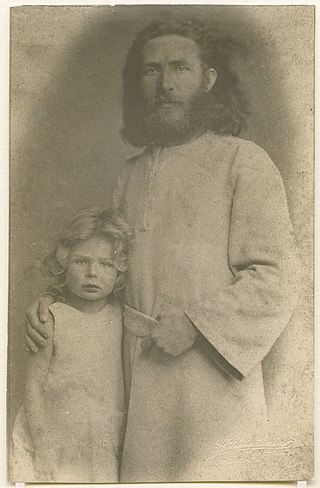
Karl Wilhelm Diefenbach was a German painter and social reformer.

Lebensreform ("life-reform") is the German generic term for various social reform movements, that started since the mid-19th century and originated especially in the German Empire and later in Switzerland. Common features were the criticism of industrialisation, materialism and urbanization combined with striving for the state of nature. The painter and social reformer Karl Wilhelm Diefenbach is considered to be an important pioneer of the Lebensreform ideas. The various movements did not have an overarching organization, but there were numerous associations. Whether the reform movements of the Lebensreform should be classified as modern or as anti-modern and reactionary is controversial. Both theses are represented.

The Verein für germanisches Heidentum, abbreviated VfGH, is a Germanic neopagan organisation in Germany. It began in 1994 as the German chapter of the British Odinic Rite and was called the Odinic Rite Deutschland. It became independent in 2004 and changed its name in 2006. Though it has never had many members, it is nonetheless influential among German neopagans. Prominent people within the organisation have included Bernd Hicker, who was its first leader, and Fritz Steinbock, who has managed and influenced its religious practice.

Richard Ungewitter was a German naturist and pioneer of the Freikörperkultur movement and one of its first organizers. There was a völkisch element in Ungewitter's ideas.
The Gylfilites' Guild, also known by the adherents' or movement's names the Gylfilites or Gylfilitism, is a Germanic Heathen sect of Ariosophical-Armanic orientation based in Krefeld, North Rhine-Westphalia, which gathered public attention in 1976. The sect published the magazine named Odrörir, the name of the mead of poetry. Since the 1990s the group has gone underground.
Naturism is a cultural and social movement practicing, advocating and defending social nudity in private and in public. It is particularly strong in Germany where it goes under the name Freikörperkultur (FKK). It refers to a lifestyle based on personal, family and/or social nudism in the "great outdoors" environment. Naturism grew out of the German Lebensreform movement and the Wandervogel youth movement of 1896, and has been adopted in many neighbouring European countries and was taken by the German diaspora to North America and other continents.
Hermann Schmiechen was a German portrait painter and Theosophist.

Heinz Trökes was a German painter, printmaker and art teacher.
Otto Sigfrid Reuter was a German writer and organiser who was central in the neopagan current within the völkisch movement. He had a career in telecommunications and began his völkisch-religious activities with the 1910 pamphlet Sigfrid oder Christus?! He founded some of the earliest organisations for Germanic neopaganism, which adhered to the racial ideologies of the völkisch movement. Reuter promoted a decentralised version of pagan practice without priests, in contrast to the hierarchically structured Germanic Faith Community of Ludwig Fahrenkrog. Reuter's theories have been described as parascientific. His major theoretical work Germanische Himmelskunde (1934) is about the Germanic star map.

